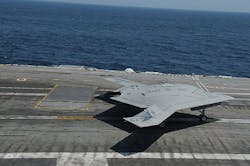Pratt & Whitney powers Northrop Grumman X-47B in U.S. Navy Unmanned Combat Air System Demonstrator
EAST HARTFORD, Conn., 12 July 2013. Pratt & Whitney's F100-PW-220U engine and exhaust system powered the first carrier-based catapult launch, touch and go, and arrested landing of Northrop Grumman's X-47B flight test aircraft for the U.S. Navy's Unmanned Combat Air System Carrier Demonstrator (UCAS-D) program.
The historic events took place aboard the USS GEORGE H.W. BUSH (CV 77) off the coast of Virginia.
The unmanned aircraft launched from the deck of USS GEORGE H.W. BUSH on 10 May and safely transited across the Chesapeake Bay to land at Naval Air Station Patuxent River, Md., after a 65-minute flight. Less than a week after completing its first catapult launch from the carrier deck the X-47B executed its first touch and go landings aboard the USS George H.W. Bush.
On 10 July, the X-47B completed its first-ever carrier-based arrested landing on board USS George H.W. Bush off the coast of Virginia.
"Achieving these milestones is exciting news for Pratt & Whitney and a major achievement for our company in demonstrating the capability and flexibility of our technology. We have worked several years with Northrop Grumman, the U.S. Navy and our industry partners to achieve these successes," says Jimmy Reed, Pratt & Whitney's director of Advanced Programs, whose team supplied the engines for the UCAS-D program. "Throughout this program, our F100-PW-220U engines have performed flawlessly and we feel proud of our product and our support of this program."
Northrop Grumman awarded a contract to Pratt & Whitney in 2008 to develop and integrate the engine and exhaust system for the X-47B. The Pratt & Whitney F100-PW-220U engine, a derivative of the F100-PW-220 and -220E engine models that power the F-15 Eagle and F-16 Falcon, enjoys the maturity gained from more than 12 million hours of operational experience. The engine and unique exhaust system have successfully completed ground accelerated mission testing. The accelerated mission test simulated the planned usage of the propulsion system during the X-47B flight test program. This endurance test demonstrated the durability and performance of the F100-PW-220U unique engine hardware and the exhaust system.
The F100-PW-220U engine is capable of providing up to 16,000 pounds of thrust and is recommended for operation in a maritime environment, including carrier deck operations. Pratt & Whitney's F100-PW-220 components and processes are common to today's F100-PW-229 and F119 and F135 family of engine technologies that allow low-risk spiral development for operational flexibility and increased fleet commonality.
Pratt & Whitney is a United Technologies Corp. (NYSE:UTX) company.



